Evolution of Urban Haze in Greater Bangkok and Association with Local Meteorological and Synoptic Characteristics during Two Recent Haze Episodes
Abstract
1. Introduction
2. Data and Methods
2.1. Study Area
2.2. Data
2.3. Selection of Haze Episodes
2.4. Synoptic Patterns
- Pattern 0: No distinct synoptic features over the Indochina. The ITCZ tends to stay over the central or lower portions of the Gulf of Thailand. On some days over GBK and the central region, clouds develop or scatter from the ITCZ edge;
- Pattern 1: A cold surge propagates southward, and its front reaching the Indochina with relatively weak pressure gradients (i.e., weak winds) over the central region. For the ITCZ and clouds, same as Pattern 0;
- Pattern 2: When the cold surge continues to propagate southward and its front reaching in the central region with moderate-to-strong pressure gradients (i.e., stronger winds). Clouds over GBK and central region are quite limited;
- Pattern 3: When the cold surge weakens over the central region, or its front recedes northward or dissipates. For the ITCZ and clouds, same as Pattern 0.
2.5. Temperature Inversion and Obukhov Length
2.6. Back-Trajectories
3. Results and Discussion
3.1. Haze Episode EP1
3.2. Haze Episode EP2
4. Conclusions
- (1)
- Local and synoptic meteorological factors play an important role in the elevated haze over Greater Bangkok. This poses a challenge to haze mitigation by emission reduction. Cold surge leads to an abrupt change in local meteorological conditions with less atmospheric ventilation as a result. A time window to apply control measures for haze is thus limited, emphasizing readiness in haze mitigation responses and early public warning with reliable weather/air quality forecasting.
- (2)
- Apart from conventional anthropogenic emissions, biomass burning is another emission sector that potentially contributes to the urban haze in the study area. Thus, agricultural burning and forest fires need to be considered, and better controlled/managed in support of haze mitigation.
- (3)
- It is fair to say that the contributing degrees of different emission sectors (i.e., anthropogenic and biomass burning) may vary by episode or over days within an episode and that secondary aerosols can as well form and partly contribute. Haze-related policymaking needs an integrated approach dealing with all important emission sectors for both particulate and gaseous precursors.
Supplementary Materials
Author Contributions
Funding
Acknowledgments
Conflicts of Interest
References
- Zhang, R.; Wang, G.; Guo, S.; Zamora, M.L.; Ying, Q.; Lin, Y.; Wang, W.; Hu, M.; Wang, Y. Formation of urban fine particulate matter. Chem. Rev. 2015, 115, 3803–3855. [Google Scholar] [CrossRef] [PubMed]
- Seinfeld, J.H.; Pandis, S.N. Atmospheric Chemistry and Physics from Air Pollution to Climate Change, 2nd ed.; John Wiley & Sons, Inc.: New York, NY, USA, 2006; ISBN 9780471720171. [Google Scholar]
- Health Effects Institute (HEI). State of Global Air 2017; A Special Report on Global Exposure to Air Pollution and Its Disease Burden; Health Effects Institute, The Institute for Health Metrics and Evaluation, University of British Columbia: Boston, MA, USA, 2018; Available online: https://www.stateofglobalair.org/sites/default/files/soga_2017_report.pdf (accessed on 15 September 2020).
- Sun, Y.; Chen, C.; Zhang, Y.; Xu, W.; Zhou, L.; Cheng, X.; Zheng, H.; Ji, D.; Li, J.; Tang, X.; et al. Rapid formation and evolution of an extreme haze episode in Northern China during winter 2015. Sci. Rep. 2016, 6, 27151. [Google Scholar] [CrossRef] [PubMed]
- Song, M.; Liu, X.; Tan, Q.; Feng, M.; Qu, Y.; An, J. Characteristics and formation mechanism of persistent extreme haze pollution events in Chengdu, southwestern China. Environ. Pollut. 2019, 251, 1–12. [Google Scholar] [CrossRef] [PubMed]
- Chen, L.; Zhu, J.; Liao, H.; Gao, Y.; Qiu, Y.; Zhang, M.; Liu, Z.; Li, N.; Wang, Y. Assessing the formation and evolution mechanisms of severe haze pollution in the Beijing–Tianjin–Hebei region using process analysis. Atmos. Chem. Phys. 2019, 19, 10845–10864. [Google Scholar] [CrossRef]
- Dai, Z.; Liu, D.; Yu, K.; Cao, L.; Jiang, Y. Meteorological variables and synoptic patterns associated with air pollutions in eastern China during 2013–2018. Int. J. Environ. Res. Public Health 2020, 17, 2528. [Google Scholar] [CrossRef] [PubMed]
- Kanawade, V.P.; Srivastava, A.K.; Ram, K.; Asmi, E.; Vakkari, V.; Soni, V.K.; Varaprasad, V.; Sarangi, C. What caused severe air pollution episode of November 2016 in New Delhi? Atmos. Environ. 2020, 222, 117125. [Google Scholar] [CrossRef]
- Wang, S.; Liao, T.; Wang, L.; Sun, Y. Process analysis of characteristics of the boundary layer during a heavy haze pollution episode in an inland megacity, China. J. Environ. Sci. 2016, 40, 138–144. [Google Scholar] [CrossRef]
- Guo, S.; Hu, M.; Zamora, M.L.; Peng, J.; Shang, D.; Zheng, J.; Du, Z.; Wu, Z.; Shao, M.; Zeng, L.; et al. Elucidating severe urban haze formation in China. Proc. Natl. Acad. Sci. USA 2014, 111, 17373–17378. [Google Scholar] [CrossRef]
- Yu, S.; Li, P.; Wang, L.; Wu, Y.; Wang, S.; Liu, K.; Zhu, T.; Zhang, Y.; Hu, M.; Zeng, L.; et al. Mitigation of severe urban haze pollution by a precision air pollution control approach. Sci. Rep. 2018, 8, 41598. [Google Scholar] [CrossRef]
- Mishra, D.; Goyal, P.; Upadhyay, A. Artificial intelligence based approach to forecast PM2.5 during haze episodes: A case study of Delhi, India. Atmos. Environ. 2015, 102, 239–248. [Google Scholar] [CrossRef]
- Huang, R.J.; Zhang, Y.; Bozzetti, C.; Ho, K.F.; Cao, J.J.; Han, Y.; Daellenbach, K.R.; Slowik, J.G.; Platt, S.M.; Canonaco, F.; et al. High secondary aerosol contribution to particulate pollution during haze events in China. Nature 2015, 514, 218–222. [Google Scholar] [CrossRef] [PubMed]
- Quan, J.; Tie, X.; Zhang, Q.; Liu, Q.; Li, X.; Gao, Y.; Zhao, D. Characteristics of heavy aerosol pollution during the 2012–2013 winter in Beijing, China. Atmos. Environ. 2014, 88, 83–89. [Google Scholar] [CrossRef]
- Zhang, Y.L.; Cao, F. Fine particulate matter (PM2.5) in China at a city level. Sci. Rep. 2015, 5, 14884. [Google Scholar] [CrossRef]
- Zhang, Q.; Quan, J.; Tie, X.; Li, X.; Liu, Q.; Gao, Y.; Zhao, D. Effects of meteorology and secondary particle formation on visibility during heavy haze events in Beijing, China. Sci. Total Environ. 2015, 502, 578–584. [Google Scholar] [CrossRef]
- Mao, M.; Zhang, X.; Shao, Y.; Yin, Y. Spatiotemporal variations and factors of air quality in urban central China during 2013–2015. Int. J. Environ. Res. Public Health 2019, 17, 229. [Google Scholar] [CrossRef] [PubMed]
- Van Ulden, A.P.; Holtslag, A.A.M. Estimation of atmospheric boundary layer parameters for diffusion applications. J. Clim. Appl. Meteor. 1985, 24, 1196–1207. [Google Scholar] [CrossRef]
- Quan, J.; Gao, Y.; Zhang, Q.; Tie, X.; Cao, J.; Han, S.; Meng, J.; Chen, P.; Zhao, D. Evolution of planetary boundary layer under different weather conditions, and its impact on aerosol concentrations. Particuology 2013, 11, 34–40. [Google Scholar] [CrossRef]
- Petaja, T.; Jarvi, L.; Kerminen, V.M.; Ding, A.J.; Sun, J.N.; Nie, W.; Kujansuu, J.; Virkkula, A.; Yang, X.Q.; Fu, C.B.; et al. Enhanced air pollution via aerosol-boundary layer feedback in China. Sci. Rep. 2015, 6, 18998. [Google Scholar] [CrossRef]
- Tie, X.; Huang, R.J.; Cao, J.; Zhang, Q.; Cheng, Y.; Su, H.; Chang, D.; Pöschl, U.; Hoffmann, T.; Dusek, U.; et al. Severe pollution in China amplified by atmospheric moisture. Sci. Rep. 2017, 7, 15760. [Google Scholar] [CrossRef]
- Liu, Q.; Jia, X.; Quan, J.; Li, J.; Li, X.; Wu, Y.; Chen, D.; Wang, Z.; Liu, Y. New positive feedback mechanism between boundary layer meteorology and secondary aerosol formation during severe haze events. Sci. Rep. 2018, 8, 41598. [Google Scholar] [CrossRef]
- Li, X.; Wang, Y.; Zhao, H.; Hong, Y.; Liu, N.; Ma, Y. Characteristics of pollutants and boundary layer structure during two haze events in summer and autumn 2014 in Shenyang, northeast China. Aerosol. Air Qual. Res. 2018, 18, 386–396. [Google Scholar] [CrossRef]
- Li, X.; Wang, Y.; Shen, L.; Zhang, H.; Zhao, H.; Zhang, Y.; Ma, Y. Characteristics of boundary layer structure during a persistent haze event in the central Liaoning city cluster, northeast China. J. Meteorol. Res. 2018, 32, 302–312. [Google Scholar] [CrossRef]
- Huaqing, P.; Duanyang, L.; Bin, Z.; Yan, S.; Jiamei, W.; Hao, S.; Jiansu, W.; Lu, C. Boundary-layer characteristics of persistent regional haze events and heavy haze days in eastern China. Adv. Meteorol. 2015, 2016. [Google Scholar] [CrossRef]
- Li, Q.; Wu, B.; Liu, J.; Zhang, H.; Cai, X.; Song, Y. Characteristics of the atmospheric boundary layer and its relation with PM2.5 during haze episodes in winter in the north China plain. Atmos. Environ. 2020, 223, 117265. [Google Scholar] [CrossRef]
- Ye, X.; Song, Y.; Cai, X.; Zhang, H. Study on the synoptic flow patterns and boundary layer process of the severe haze events over the north China plain in January 2013. Atmos. Environ. 2016, 124, 129–145. [Google Scholar] [CrossRef]
- Pollution Control Department (PCD). Thailand State of Pollution 2017; Pollution Control Department: Bangkok, Thailand, 2018.
- Chuersuwan, N.; Nimrat, S.; Lekphet, S.; Kerdkumrai, T. Levels and major sources of PM2.5 and PM10 in Bangkok Metropolitan Region. Environ. Int. 2008, 34, 671–677. [Google Scholar] [CrossRef]
- Wimolwattanapun, W.; Hopke, P.K.; Pongkiatkul, P. Source apportionment and potential source locations of PM2.5 and PM2.5–10 at residential sites in metropolitan Bangkok. Atmos. Pollut. Res. 2011, 2, 172–181. [Google Scholar] [CrossRef]
- ChooChuay, C.; Pongpiachan, S.; Tipmanee, D.; Suttinun, O.; Deelaman, W.; Wang, Q.; Xing, L.; Li, G.; Han, Y.; Palakun, J.; et al. Impacts of PM2.5 sources on variations in particulate chemical compounds in ambient air of Bangkok, Thailand. Atmos. Pollut. Res. 2020, 11, 1657–1667. [Google Scholar] [CrossRef]
- Narita, D.; Oanh, N.T.K.; Sato, K.; Huo, M.; Permadi, D.A.; Chi, N.N.H.; Ratanajaratroj, T.; Pawarmart, I. Pollution characteristics and policy actions on fine particulate matter in a growing Asian economy: The case of Bangkok Metropolitan Region. Atmosphere 2019, 10, 227. [Google Scholar] [CrossRef]
- Phairuang, W.; Suwattiga, P.; Chetiyanukornkul, T.; Hongtieab, S.; Limpaseni, W.; Ikemori, F.; Hata, M.; Furuuchi, M. The influence of the open burning of agricultural biomass and forest fires in Thailand on the carbonaceous components in size-fractionated particles. Environ. Pollut. 2019, 247, 238–247. [Google Scholar] [CrossRef]
- Dejchanchaiwong, R.; Tekasakul, P.; Tekasakul, S.; Phairuang, W.; Nim, N.; Sresawasd, C.; Thongboon, K.; Thongyen, T.; Suwattiga, P. Impact of transport of fine and ultrafine particles from open biomass burning on air quality during 2019 Bangkok haze episode. J. Environ. Sci. 2020, 97, 238–247. [Google Scholar] [CrossRef] [PubMed]
- Kayee, J.; Sompongchaiyakul, P.; Sanwlani, N.; Bureekul, S.; Wang, X.; Das, R. Metal concentrations and source apportionment of PM2.5 in Chiang Rai and Bangkok, Thailand during a biomass burning season. ACS Earth Space Chem. 2020, 4, 1213–1226. [Google Scholar] [CrossRef]
- Pham, T.B.T.; Manomaiphiboon, K.; Vongmahadlek, C. Development of an inventory and temporal allocation profiles of emissions from power plants and industrial facilities in Thailand. Sci. Total Environ. 2008, 397, 103–118. [Google Scholar] [CrossRef] [PubMed]
- Thongthammachart, T.; Jinsart, W. Estimating PM2.5 concentrations with statistical distribution techniques for health risk assessment in Bangkok. Hum. Ecol. Risk Assess. 2020, 26, 1848–1863. [Google Scholar] [CrossRef]
- Fold, N.R.; Allison, M.R.; Wood, B.C.; Pham, T.B.T.; Bonnet, S.; Garivait, S.; Kamens, R.; Pengjan, S. An assessment of annual mortality attributable to ambient PM2.5 in Bangkok, Thailand. Int. J. Environ. Res. Public Health 2020, 17, 7298. [Google Scholar] [CrossRef]
- DOPA–Department of Provincial Administration. Statistic of Population by Province in 2017. Available online: https://stat.bora.dopa.go.th/stat/pk/pk_60.pdf (accessed on 28 September 2020).
- National Economic and Social Development Board (NESDB). Gross Regional and Provincial Product, Chain Volume Measures, 2018th ed.; Office of the National Economic and Social Development Board: Bangkok, Thailand, 2018. Available online: https://www.nesdc.go.th/nesdb_en/ewt_w3c/ewt_dl_link.php?filename=national_account&nid=4317 (accessed on 28 September 2020).
- Land Development Department (LDD). Land Use and Land Cover Data for Thailand for the Years 2012–2016; Land Development Department: Bangkok, Thailand, 2016.
- Thai Meteorological Department (TMD). The Climate of Thailand. Thai Meteorological Department. Available online: https://www.tmd.go.th/en/archive/thailand_climate.pdf (accessed on 28 September 2020).
- Chang, C.P.; Harr, P.A.; Chen, H.J. Synoptic disturbances over the equatorial south China sea and western maritime continent during boreal winter. Mon. Weather Rev. 2005, 133, 489–503. [Google Scholar] [CrossRef]
- Ashfold, M.J.; Latif, M.T.; Samah, A.A.; Mead, M.I.; Harris, N.R.P. Influence of northeast monsoon cold surges on air quality in Southeast Asia. Atmos. Environ. 2017, 166, 498–509. [Google Scholar] [CrossRef][Green Version]
- Yavinchan, S.; Exell, R.H.B.; Sukawat, D. Convective parameterization in a model for prediction of heavy rain in southern Thailand. J. Meteor. Soc. Jpn. 2011, 89A, 201–224. [Google Scholar] [CrossRef]
- Zahumenský, I. Guidelines on Quality Control Procedures for Data from Automatic Weather Stations. World Meteorolgical Organziation. 2004. Available online: https://www.wmo.int/pages/prog/www/IMOP/meetings/Surface/ET-STMT1_Geneva2004/Doc6.1(2).pdf (accessed on 13 February 2019).
- Aman, N.; Manomaiphiboon, K.; Pengchai, P.; Suwanathada, P.; Srichawana, J.; Assareh, N. Long-term observed visibility in eastern Thailand: Temporal variation, association with air pollutants and meteorological factors, and trends. Atmosphere 2019, 10, 122. [Google Scholar] [CrossRef]
- R Development Core Team. R: A Language and Environment for Statistical Computing (Version 3.6.1); R Foundation for Statistical Computing: Vienna, Austria, 2019; Available online: https://www.R-project.org/ (accessed on 20 June 2020).
- Saha, S.; Moorthi, S.; Pan, H.L.; Wu, X.; Wang, J.; Nadiga, S.; Tripp, P.; Kistler, R.; Woollen, J.; Behringer, D.; et al. The NCEP climate forecast system reanalysis. Bull. Am. Meteorol. Soc. 2010, 91, 1015–1057. [Google Scholar] [CrossRef]
- Stull, R.B. An Introduction to Boundary Layer Meteorology; Kluwer Academic Publishers: Dordrecht, The Netherlands, 1998. [Google Scholar]
- Kamma, J.; Manomaiphiboon, K.; Aman, N.; Thongkamdee, T.; Chuangchote, S.; Bonnet, S. Urban heat island analysis for Bangkok: Multi-scale temporal variation, associated factors, directional dependence, and cool island condition. ScienceAsia 2020, 46, 213–223. [Google Scholar] [CrossRef]
- Stewart, I.D.; Oke, T.R. Local climate zones for urban temperature studies. Bull. Am. Meteorol. Soc. 2012, 12, 1879–1900. [Google Scholar] [CrossRef]
- Sáenz, J.; González-Rojí, S.J.; Madinabeitia, S.C.; Berastegi, G.I. Atmospheric Thermodynamics and Visualization. R Package Version 1.2.1. 2018. Available online: https://cran.r-project.org/web/packages/aiRthermo/index.html (accessed on 20 June 2020).
- Rodell, M.; Houser, P.R.; Jambor, U.; Gottschalck, J.; Mitchell, K.; Meng, C.J.; Arsenault, K.; Cosgrove, B.; Radakovich, J.; Bosilovich, M.; et al. The global land data assimilation system. Bull. Am. Meteor. Soc. 2004, 85, 381–394. [Google Scholar] [CrossRef]
- Stein, A.F.; Draxler, R.R.; Rolph, G.D.; Stunder, B.J.B.; Cohen, M.D.; Ngan, F. NOAA’s Hysplit atmospheric transport and dispersion modeling system. Bull. Am. Meteorol. Soc. 2015, 96, 2059–2077. [Google Scholar] [CrossRef]
- Giglio, L.; Schroeder, W.; Justice, C.O. The collection 6 MODIS active fire detection algorithm and fire products. Remote Sens. Environ. 2016, 178, 31–41. [Google Scholar] [CrossRef]
- Japan Meteorological Agency (JMA). Annual Report on the Activities of RSMC Tokyo; Typhoon Center: Tokyo, Japan, 2018. Available online: https://www.jma.go.jp/jma/jma-eng/jma-center/rsmc-hp-pub-eg/AnnualReport/2017/Text/Text2017.pdf (accessed on 28 September 2020).
- Klimont, Z.; Kupiainen, K.; Heyes, C.; Purohit, P.; Cofala, J.; Rafaj, P.; Borken-Kleefeld, J.; Schöpp, W. Global anthropogenic emissions of particulate matter including black carbon. Atmos. Chem. Phys. 2017, 17, 8681–8723. [Google Scholar] [CrossRef]
- Pérez, I.A.; García, M.Á.; Sánchez, M.L.; Pardo, N.; Fernández-Duque, B. Key points in air pollution meteorology. Int. J. Environ. Res. Public Health 2020, 17, 8349. [Google Scholar] [CrossRef]
- Solanki, R.; Macatangay, R.; Sakulsupich, V.; Sonkaew, T.; Sarathi, P. Mixing layer height retrievals from MiniMPL measurements in the Chiang Mai valley: Implications for particulate matter pollution. Front. Earth Sci. 2019, 7. [Google Scholar] [CrossRef]
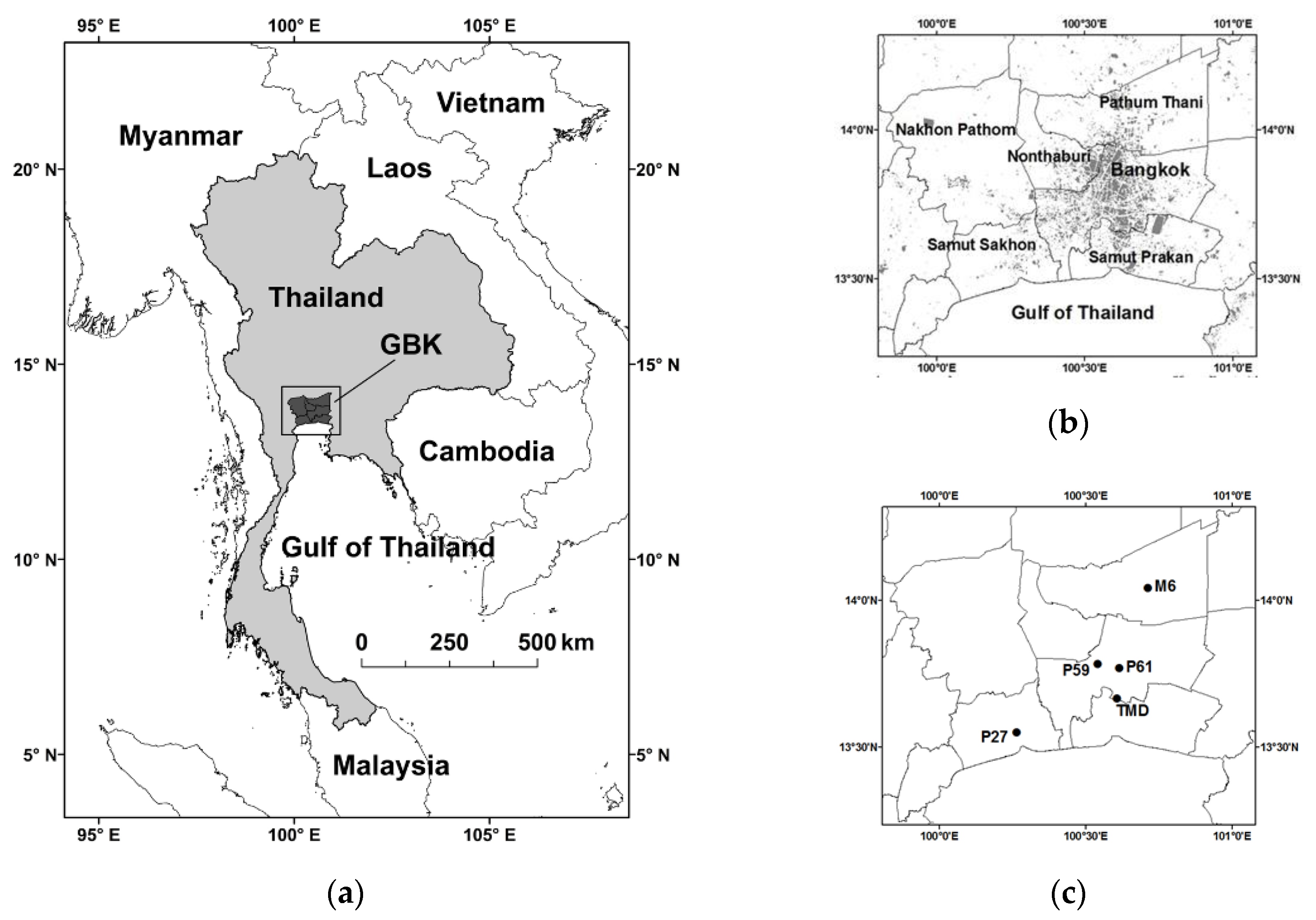
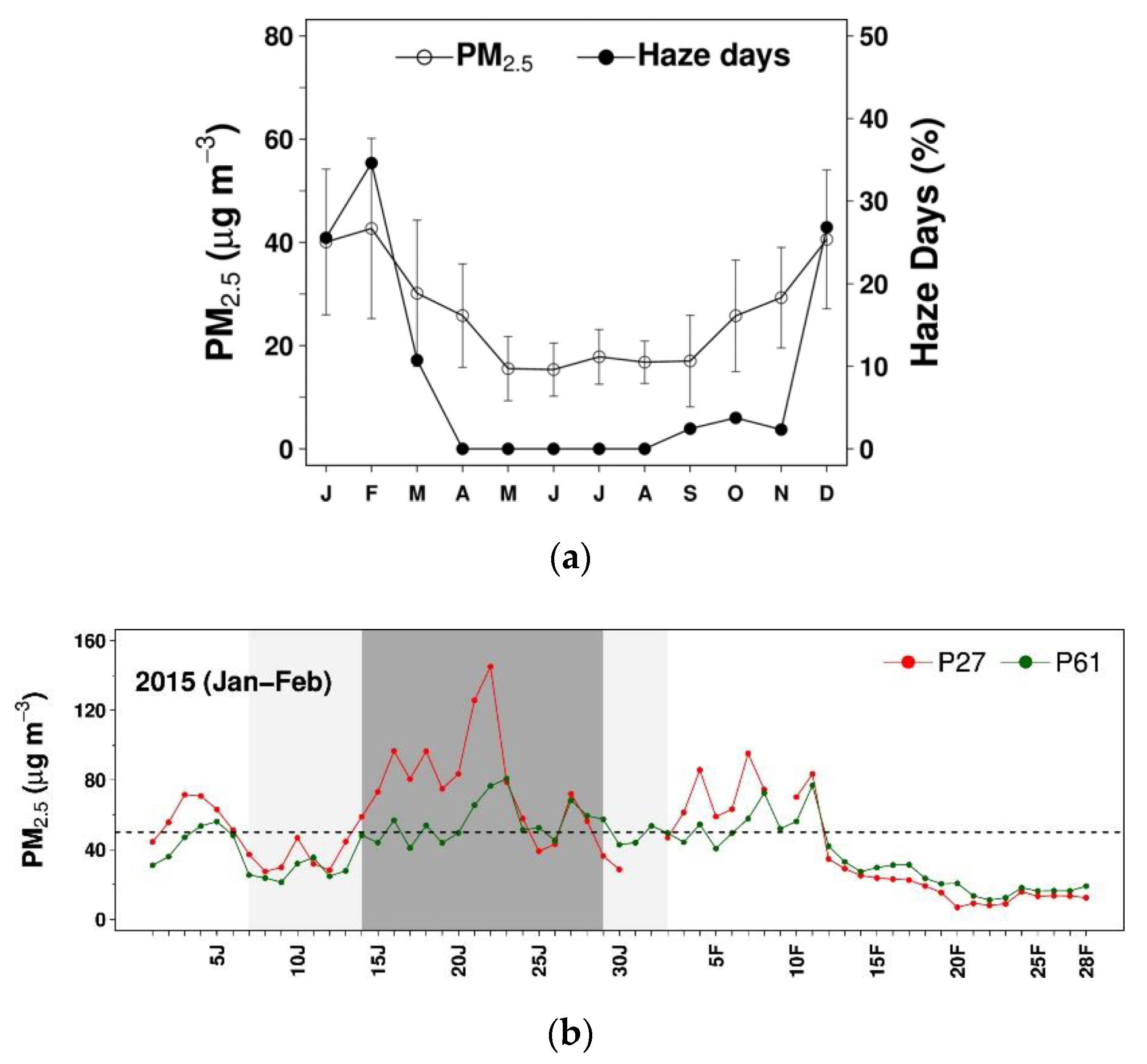
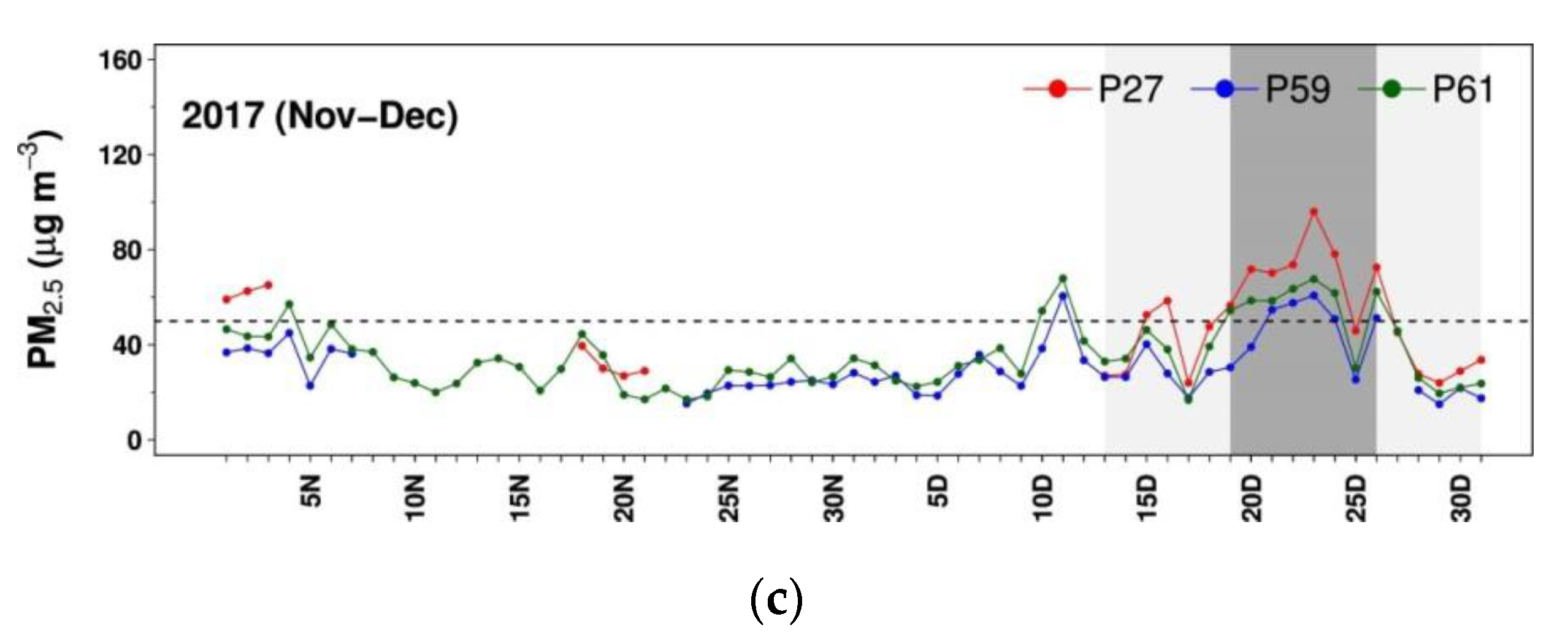
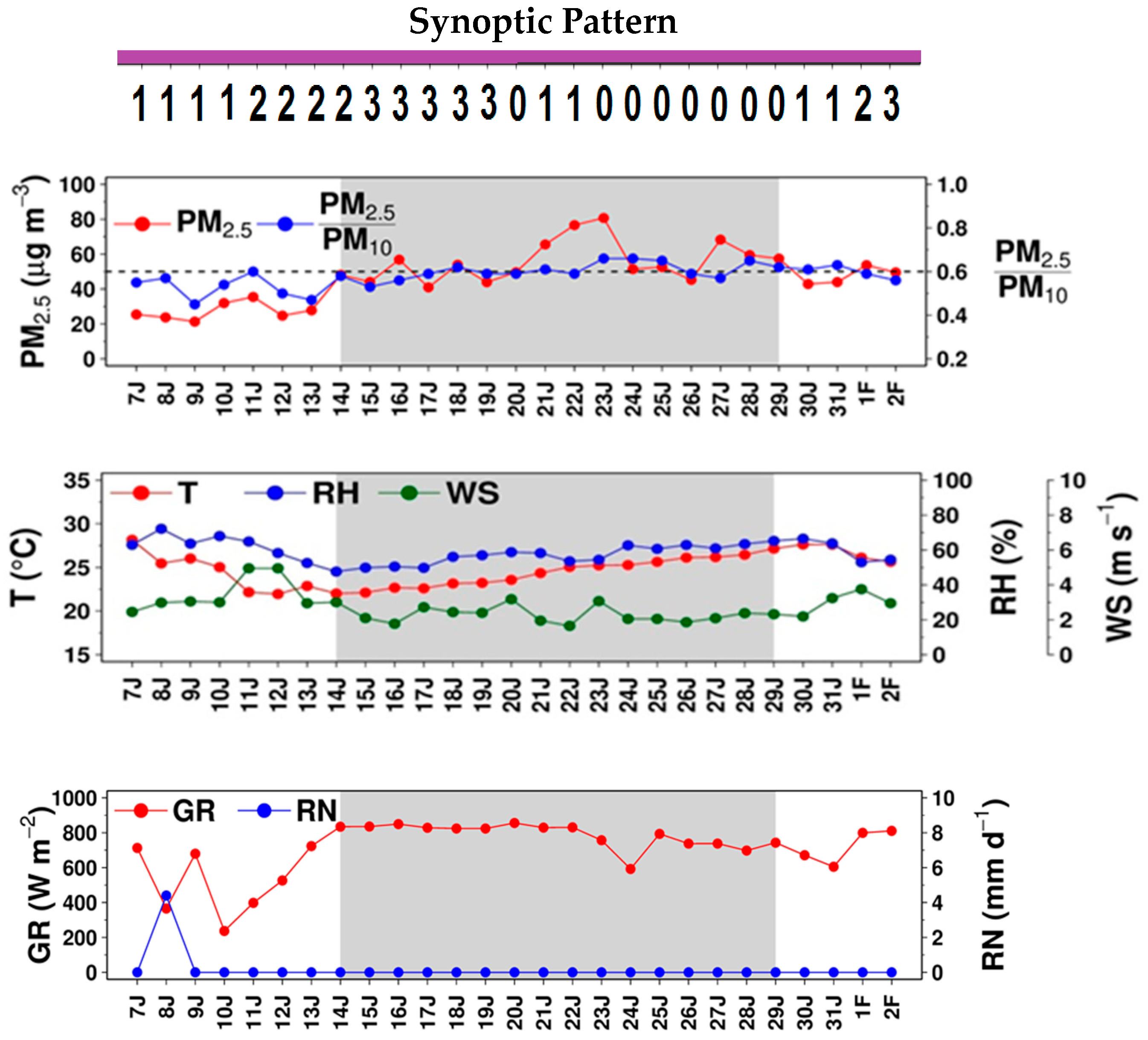
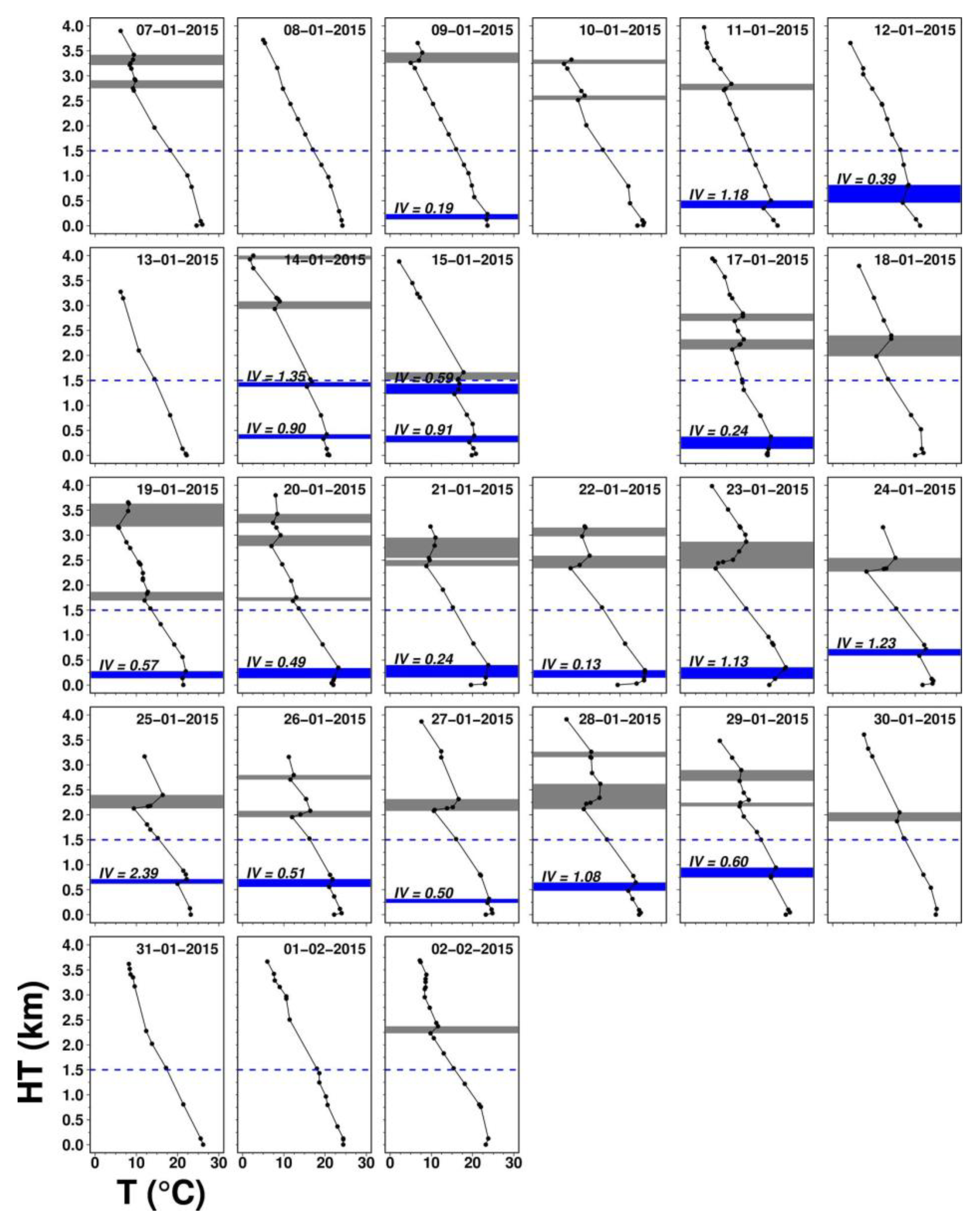
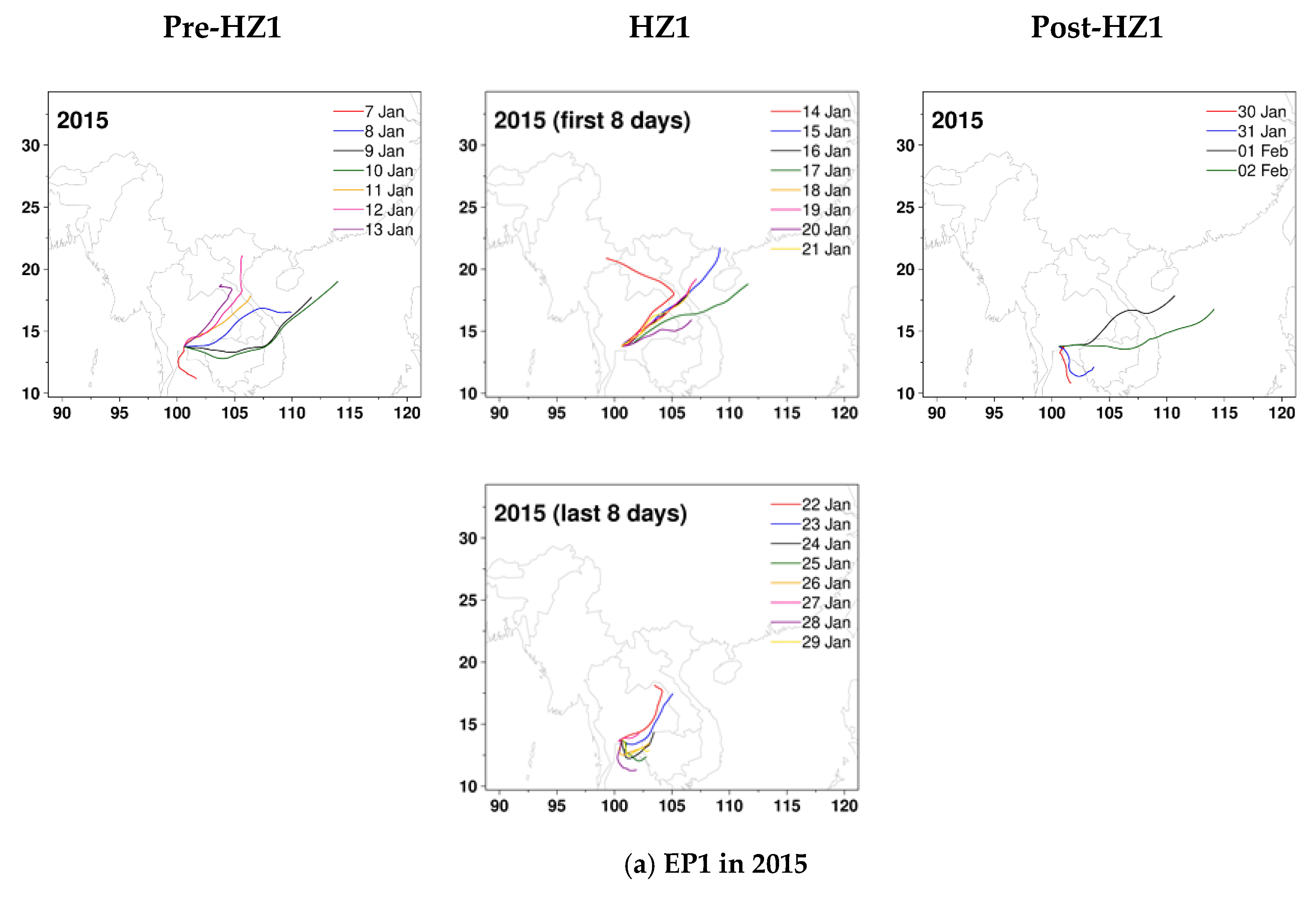
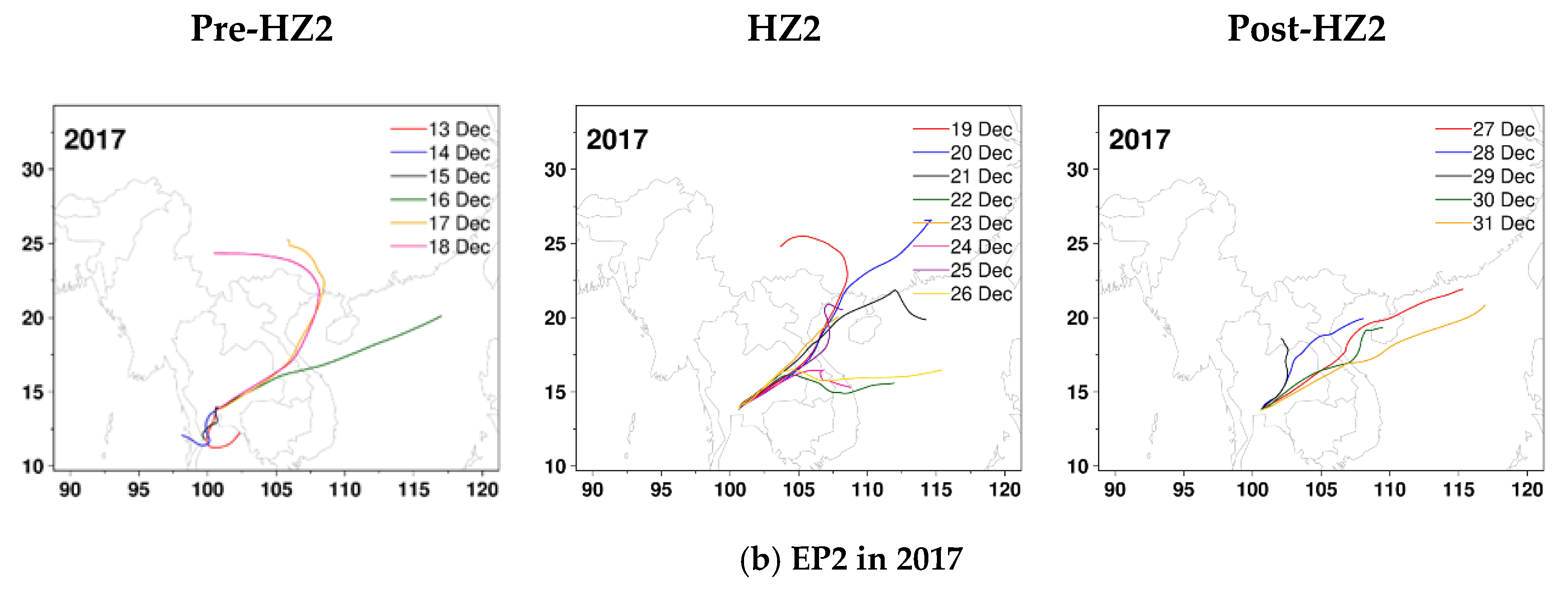
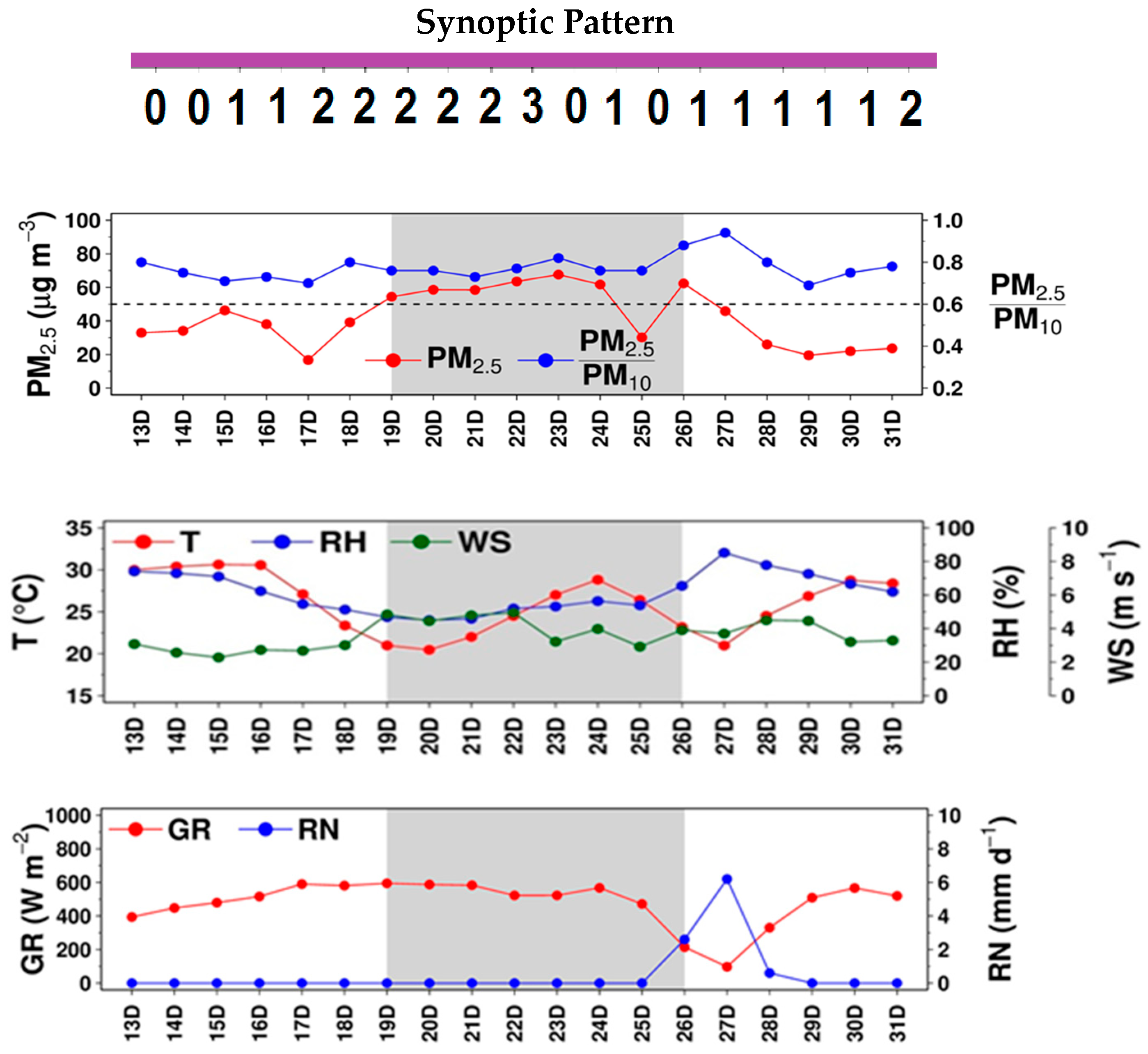
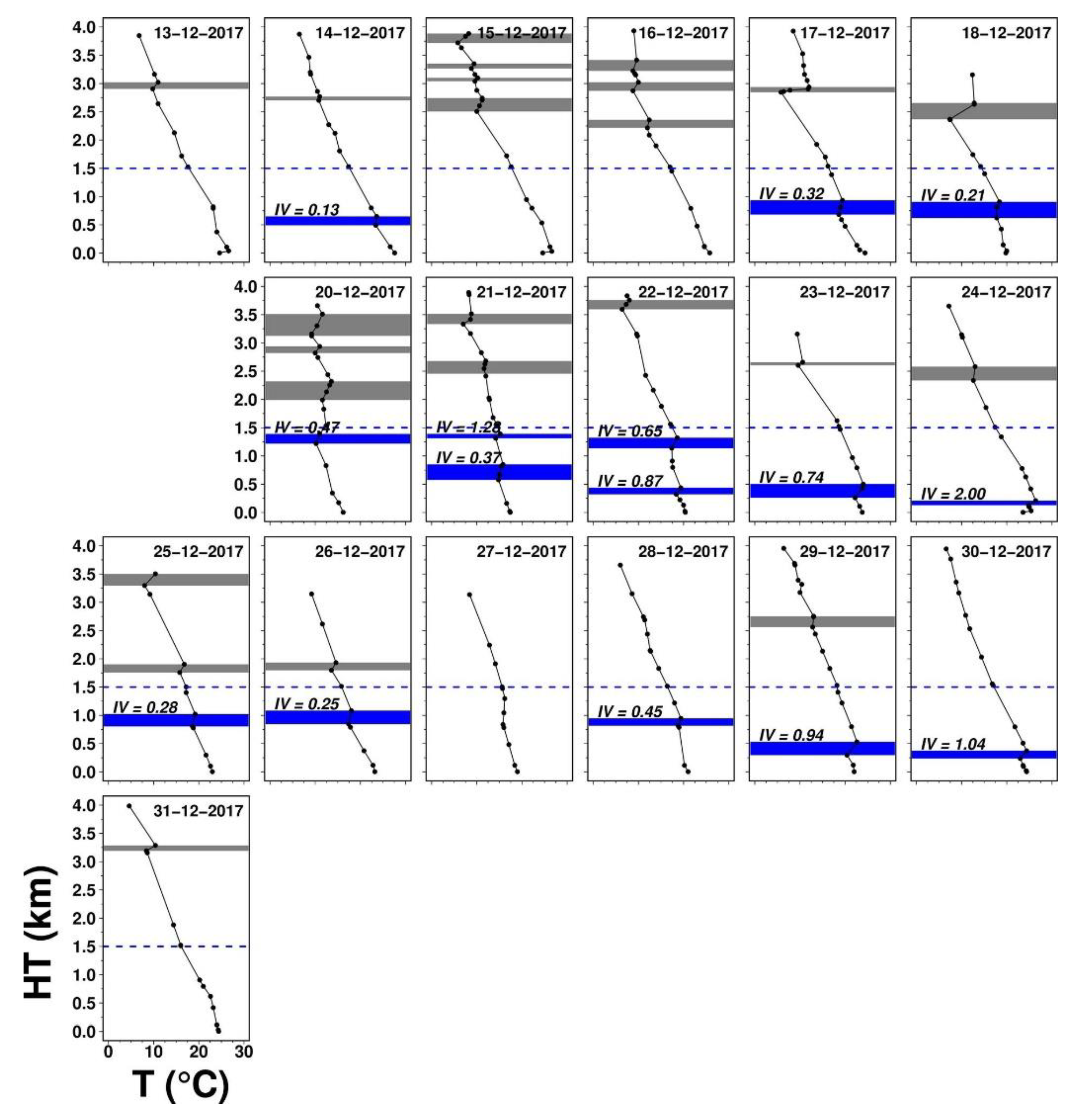
| Station | Province | Variables | Station Type (Background) |
|---|---|---|---|
| P27 | Samut Sakhon | Hourly PM2.5, and PM10 | Surface air quality (roadside or semi-general) |
| P59 | Bangkok | Hourly PM2.5, and PM10, RH | Surface air quality (semi-general) |
| P61 | Bangkok | Hourly PM2.5 and PM10 | Surface air quality (general) |
| M6 | Pathum Thani | Hourly T2, T50, WS50, WS100, WD50, WD100, RH, RN, and GR | 100-m tower (general) |
| TMD | Bangkok | T (at different heights) | Sounding at 7 LT |
Publisher’s Note: MDPI stays neutral with regard to jurisdictional claims in published maps and institutional affiliations. |
© 2020 by the authors. Licensee MDPI, Basel, Switzerland. This article is an open access article distributed under the terms and conditions of the Creative Commons Attribution (CC BY) license (http://creativecommons.org/licenses/by/4.0/).
Share and Cite
Aman, N.; Manomaiphiboon, K.; Pala-En, N.; Kokkaew, E.; Boonyoo, T.; Pattaramunikul, S.; Devkota, B.; Chotamonsak, C. Evolution of Urban Haze in Greater Bangkok and Association with Local Meteorological and Synoptic Characteristics during Two Recent Haze Episodes. Int. J. Environ. Res. Public Health 2020, 17, 9499. https://doi.org/10.3390/ijerph17249499
Aman N, Manomaiphiboon K, Pala-En N, Kokkaew E, Boonyoo T, Pattaramunikul S, Devkota B, Chotamonsak C. Evolution of Urban Haze in Greater Bangkok and Association with Local Meteorological and Synoptic Characteristics during Two Recent Haze Episodes. International Journal of Environmental Research and Public Health. 2020; 17(24):9499. https://doi.org/10.3390/ijerph17249499
Chicago/Turabian StyleAman, Nishit, Kasemsan Manomaiphiboon, Natchanok Pala-En, Eakkachai Kokkaew, Tassana Boonyoo, Suchart Pattaramunikul, Bikash Devkota, and Chakrit Chotamonsak. 2020. "Evolution of Urban Haze in Greater Bangkok and Association with Local Meteorological and Synoptic Characteristics during Two Recent Haze Episodes" International Journal of Environmental Research and Public Health 17, no. 24: 9499. https://doi.org/10.3390/ijerph17249499
APA StyleAman, N., Manomaiphiboon, K., Pala-En, N., Kokkaew, E., Boonyoo, T., Pattaramunikul, S., Devkota, B., & Chotamonsak, C. (2020). Evolution of Urban Haze in Greater Bangkok and Association with Local Meteorological and Synoptic Characteristics during Two Recent Haze Episodes. International Journal of Environmental Research and Public Health, 17(24), 9499. https://doi.org/10.3390/ijerph17249499





